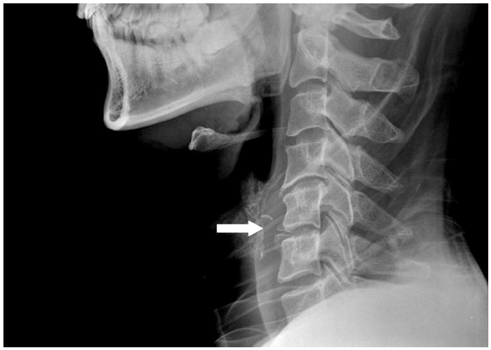J Korean Soc Radiol.
2013 Sep;69(3):235-237. 10.3348/jksr.2013.69.3.235.
Aberrant Articulation of Cervical Vertebral Transverse Process: An Uncommon Normal Variant and Review of the Literature
- Affiliations
-
- 1Department of Radiology, Hanyang University College of Medicine, Guri Hospital, Guri, Korea. ryuja@hanyang.ac.kr
- 2Department of Radiology, Hanyang University College of Medicine, Seoul Hospital, Seoul, Korea.
- KMID: 2208806
- DOI: http://doi.org/10.3348/jksr.2013.69.3.235
Abstract
- Aberrant articulation between two anterior tubercles is a rare congenital anomaly that should be considered for patients showing a bony projection anterior to the vertebral body on a lateral radiograph of the cervical spine. We present a case of an elongation of the anterior tubercles of the transverse processes of both the fifth and sixth cervical vertebrae. This finding is probably a form of supernumerary cervical rib developing at a level above the lowest cervical spine.
Figure
Reference
-
1. Lapayowker MS. An unusual variant of the cervical spine. Am J Roentgenol Radium Ther Nucl Med. 1960; 83:656–659.2. Applbaum Y, Gerard P, Bryk D. Elongation of the anterior tubercle of a cervical vertebral transverse process: an unusual variant. Skeletal Radiol. 1983; 10:265–267.3. Grilliot JR, Wiles MJ. Elongation of the anterior tubercle of a cervical vertebral transverse process. J Manipulative Physiol Ther. 1988; 11:221–223.4. Mellado JM, Larrosa R, Martín J, Yanguas N, Solanas S, Cozcolluela MR. MDCT of variations and anomalies of the neural arch and its processes: part 1--pedicles, pars interarticularis, laminae, and spinous process. AJR Am J Roentgenol. 2011; 197:W104–W113.5. Mellado JM, Larrosa R, Martín J, Yanguas N, Solanas S, Cozcolluela MR. MDCT of variations and anomalies of the neural arch and its processes: part 2--articular processes, transverse processes, and high cervical spine. AJR Am J Roentgenol. 2011; 197:W114–W121.6. Coley BD. Caffey's Pediatric Diagnostic Imaging. 12th ed. Philadelphia, PA: Mosby/Elsevier;2013. p. 1356–1427.7. Bron JL, van Royen BJ, Wuisman PI. The clinical significance of lumbosacral transitional anomalies. Acta Orthop Belg. 2007; 73:687–695.
- Full Text Links
- Actions
-
Cited
- CITED
-
- Close
- Share
- Similar articles
-
- Effectiveness of Doppler Image of the Vertebral Artery as an Anatomical Landmark for Identification of Ultrasound-Guided Target Level in Cervical Spine
- Radiologic Characteristics of Vertebral Artery Injury in the Cervical Spine Fracture
- Aberrant Right Vertebral Artery Originating from the Aortic Arch Distal to the Left Subclavian Artery: A Case Report
- Two Cases of Aberrant Vertebral Artery Originating from Aortic Arch Distal to Left Subclavian Artery
- Variations in Entrance of Vertebral Artery in Korean Cervical Spine: MDCT-based Analysis




